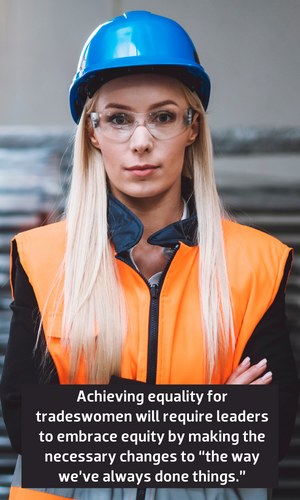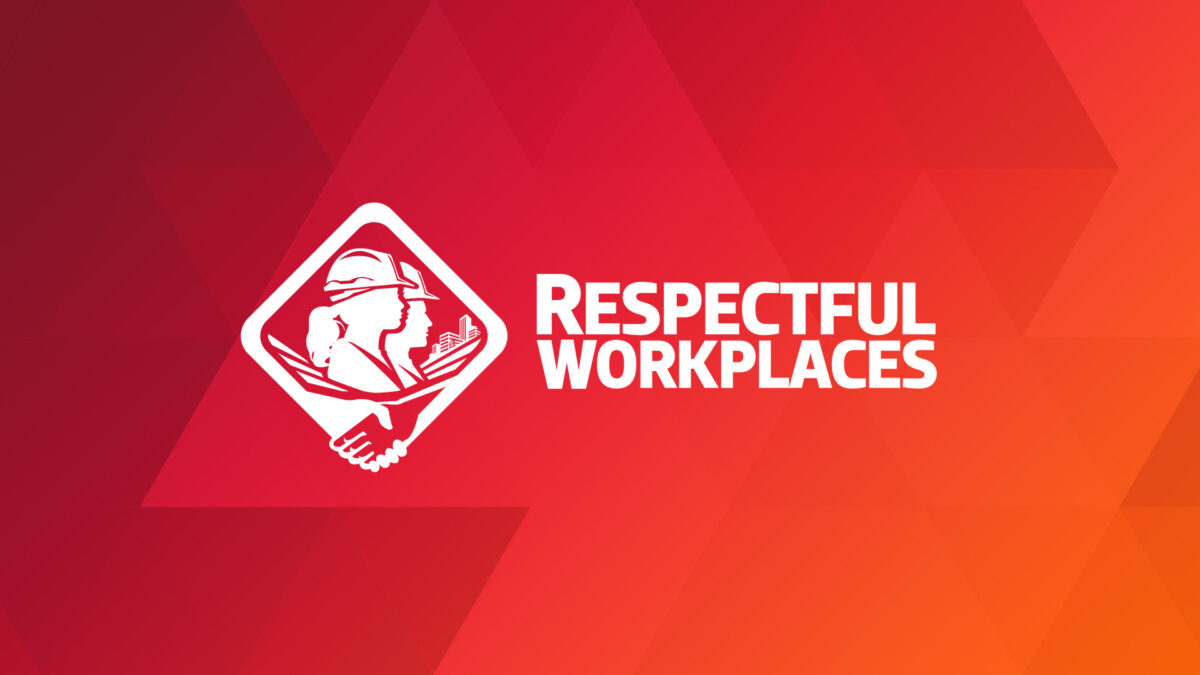Does your organization have a transformative perspective on gender equality?

This year, the theme for International Women’s Day on March 8 is “#EmbraceEquity.” Embracing equity means that an organization believes and values diversity as a necessary and positive factor in its success.
This is the motivation for an organization to understand the barriers to equality that women experience and make the necessary changes. Those changes represent the journey toward gender equality.
Most business leaders want gender equality in their organizations, and the Canadian construction industry is no different. In a 2022 Canadian survey of female and male leaders’ awareness and general views on women working as construction tradespeople, three quarters of respondents said they are very comfortable with women joining and working in the trades, and two thirds already had women working for them or as part of their union.
However, despite this positive endorsement for women’s equality in the construction industry, women represent only 4.8% of construction tradespeople.
So why aren’t there more tradeswomen? The reasons most commonly mentioned by respondents are related to gender bias: 64% said that women face discrimination by workers/supervisors and employers due to the beliefs that women aren’t suitable for trades work, because its typically a man’s job, and women don’t fit into the “macho” culture.
Where gender bias is strongly held, harassment is more likely. Respondents said that harassment and sexual harassment are also a major reason why women don’t enter and/or stay in construction trades work: 47% said women face harassment from other workers, 38% said that women face harassment from their supervisors/bosses/employers, and 48% said they face sexual harassment.
To address these challenges will require leaders who understand that achieving gender equality is a journey. A journey can simply mean a trip from one place to another; however, “journey” also implies a change in perspective that involves a length of time, learning, and experience, for example, “the journey from youth to maturity.”
The transformation of a workplace culture where there is discrimination and harassment toward women will require organizations to facilitate significant changes in “the way we’ve always done things”: the attitudes, habits of behaviour, and processes that prevent gender equality. This will require a transformative perspective about gender equality and the changes needed to get there.
Transformative perspectives
There are four transformative perspectives that can help to facilitate the journey toward gender equality.
1. “Equality” is the outcome and “equity” is the process.
In order to achieve equality, organizations must strive for “substantive equality”: the outcome of a policy or program must result in equal outcomes for all qualified people.
For example, research shows that when reviewing identical resumes, both women and men prefer to choose a candidate with a male name over one with a female name by a ratio of two to one. The recruitment process is not substantially equal because although the recruitment process is applied equally to women and men, the outcome is not equal.
“Equity” refers to the process of rectifying the recruitment policies and procedures that result in unequal outcomes, despite those policies and programs being applied equally to women and men.
2. Creating a respectful and inclusive workplace for all workers is a more effective strategy for achieving gender equality than focusing on women as the “problem.”
Focusing on measures that target women without addressing the attitudes, habits of behaviour, and processes that allow discrimination and harassment in the first place will do nothing to create a fair and welcoming work environment for not only women, but any worker deemed to be “diverse” or different in some way.
3. Workplaces cannot be respectful and inclusive if some workers are experiencing discrimination.
Discrimination is defined as an act, behavior, or decision that excludes someone or treats a person unfairly because of certain characteristics, defined as the “grounds of discrimination” such as age, gender, race, and so on.
When a policy or program results in differential outcomes for members of groups based on their demographic characteristics such as gender, human rights codes refer to this as “constructive” discrimination. An organization will be found to be discriminatory even if only some workers experience constructive discrimination.
4. Always connect respectful and inclusive initiatives to an organization’s overall strategy.
Resistance to change manifests itself in many ways from foot-dragging and inertia to petty sabotage to outright refusal to cooperate. Gender equality initiatives can be particularly unwelcome when gender bias has been allowed to flourish.
While these initiatives introduce fairness into the workplace, they can look like exclusion if the initiatives seem to favour women based solely on their gender and not on substantiated reasoning and coherent organizational strategy.
Targeted universalism is a change management approach that simultaneously aims for an organizational goal while also addressing disparities in outcomes among specific groups of workers. For example, an organization recognizes that eliminating violations of respect such as harassment is a strategic priority.
Analysis may show that workers, regardless of their gender, experience harassment. However, further analysis shows that members of specific groups experience higher levels of harassment. The organization then develops strategies that are targeted to specific groups of workers to address the disparity.
Creating an organization that welcomes and supports tradeswomen will require a transformative perspective about gender equality. Organizations must embrace equity by making the necessary changes to “the way we’ve always done things” that create barriers to gender equality. This is a journey that values and welcomes tradeswomen as a positive factor in an organization’s success.
Organizations that want to ensure their workplace is welcoming to tradeswomen could consider including the Working in a Respectful and Inclusive Workplace online course in their equity initiatives. It provides awareness about human rights codes, the myths and facts about women working in the trades, and the behaviours that support gender equality.
Resources:
- Powell, J.A., Menendian, S., Ake, W. Targeted Universalism: Policy & Practice. UC Berkeley. May 2019. See http://haasinstitute.berkeley.edu/targeteduniversalism.
- Ontario Human Rights Commission. Fact sheet #1: The Ontario Human Rights Code. See Fact Sheet #4: Poisoned environment. www.ohrc.on.ca/en/students%E2%80%99-handouts/fact-sheet-1-ontario-human-rights-code#:~:text=It%20states%20that%20every%20person,and%20recreation%20organizations%20and%20facilities
- Pollara. Survey of Industry Leaders. Ontario Building & Construction Tradeswomen. March 2022.
- Steinpreis, Rhea E., Anders, Katie A., Ritzke, Dawn. The Impact of Gender on the Review of the Curricula Vitae of Job Applicants and Tenure Candidates: A National Empirical Study. (1999). Sex Roles, Vol. 41, Nos. 7/8.
Read from the beginning. Click here to start at Part 1.
What can an effective Respectful and Inclusive Workplace Program deliver?
- Become an employer of choice – attract, retain, and advance top talent from all sources of labour
- Unlock collaboration and innovation – create high-performing teams through diversity of thought and experience
- Build your brand – your organization will gain a competitive edge as a leader and innovator
Get started today!
The BuildForce Canada Online Respectful and Inclusive Workplace Toolkit includes:
- the Respectful Workplace Online Self-Assessment Tool to assist organization leadership in assessing their current situation and identifying where they may need to make changes
- the Respectful Workplace Policy Framework and Implementation Guide to assist organizations in creating and implementing a policy that supports a respectful and inclusive workplace
- the Respectful Workplace Online Training Course to train workers on how to create and support a respectful and inclusive workplace
- the online course Introduction to Understanding Systemic Racism: A Guide for Leaders and Managers
All the resources you need to create and support a respectful and inclusive workplace!

Respectful and Inclusive Workplaces
